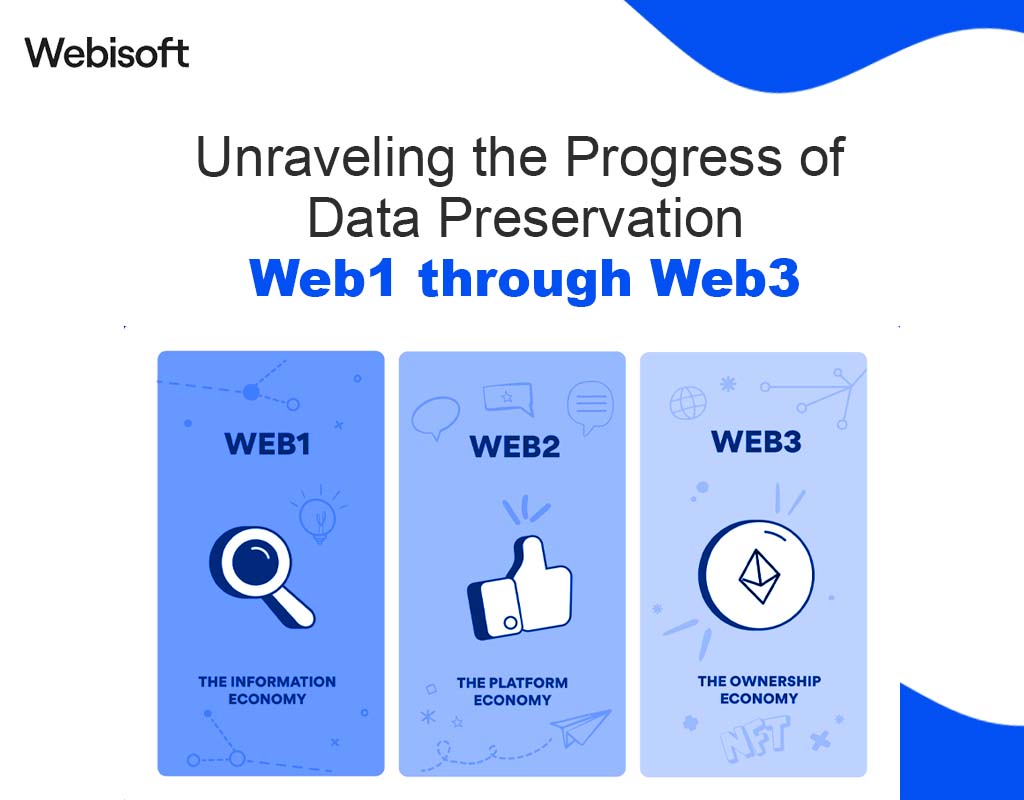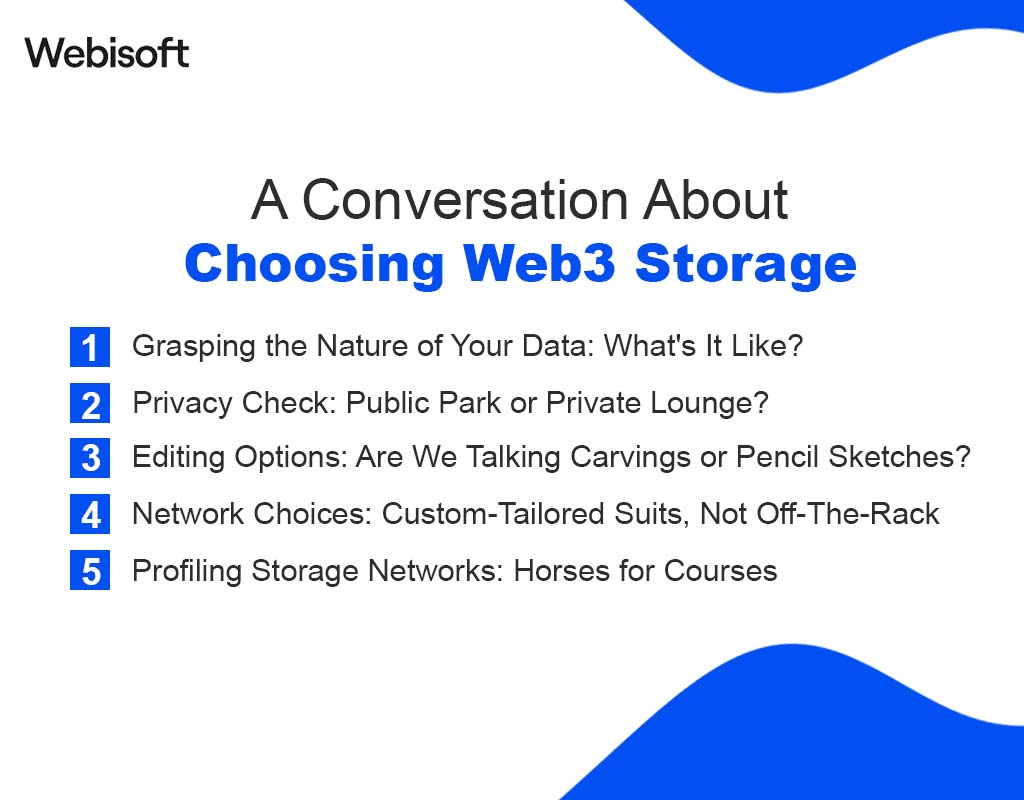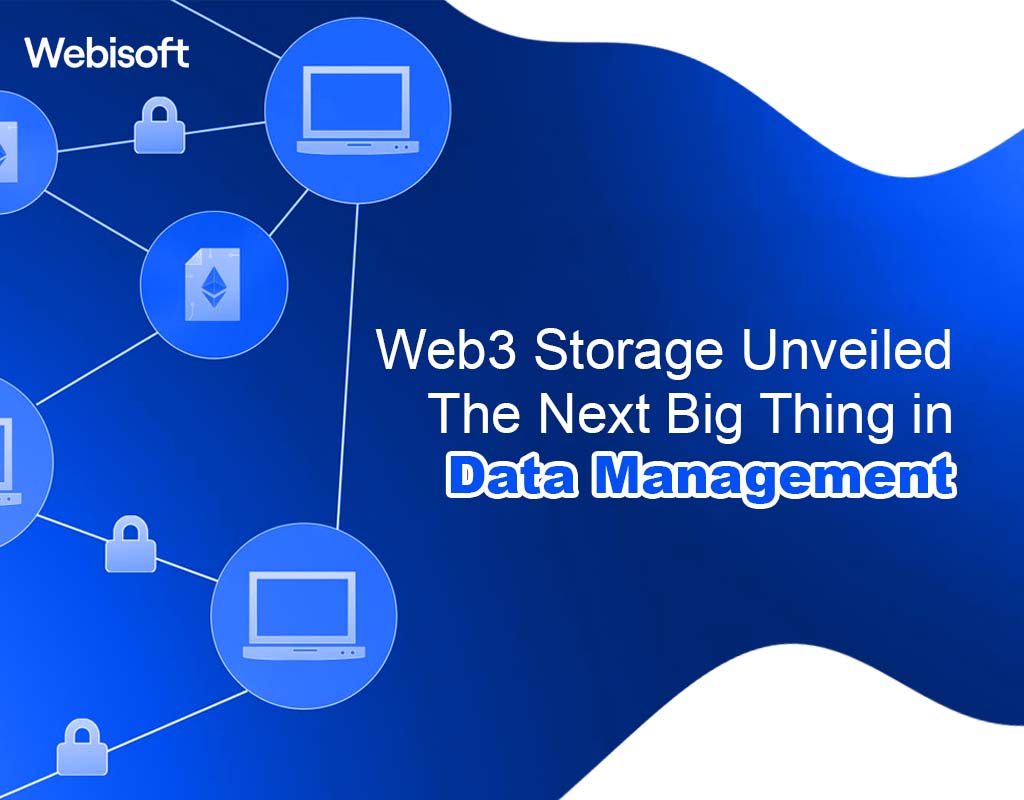The digital world is constantly evolving, and as we navigate this dynamic landscape, we stumble upon novel concepts that reshape our understanding of technology. One such pivotal concept is ‘web3 storage’. This term might be buzzing in tech circles, but what does it truly entail?
In a nutshell, web3 storage is a decentralization-focused model that marks a seismic shift from the conventional cloud storage platforms we’ve grown accustomed to. The intention is not for cloud wars.
In fact, to combat some of the critical weaknesses that traditional storage systems grapple with. Ready to dive deeper and unravel the complexities of web3 storage? Let’s explore.
Contents
Unraveling the Progress of Data Preservation: Web1 through Web3

In the primordial period of the Internet, we saw the inception of a passive web where interaction was a one-sided affair. Web1, the first iteration of the web, brought us the concept of web pages, marking a significant leap in digital content consumption.
Yet, its major limitation lay in the unidirectional communication flow, resulting in a lack of user interaction.
Users were mostly spectators, with no opportunity to create or contribute content, making this version of the web somewhat dull compared to what we have today. Users were treated as mere bystanders with no ownership rights under this centralization of control, in which creators held the reins.
Web2: Making Room for User Interaction
The dawn of Web2 revolutionized user interaction by enabling them to read and write, and in the process, unleash their creativity. Now, users could whip up blogs, craft tutorial videos, and generate other forms of content, expanding the horizons of what they could achieve online.
Customized websites and direct interaction with data became possible, empowering users to devise solutions and services that were previously unthinkable in the Web1 era.
However, while this shift towards user participation was a breath of fresh air, it was not without restrictions. The storing and hosting of user-generated data remained largely in the hands of tech titans.
The power to create and upload content online was there, but the control of that data still eluded users. As a result, the landscape of digital communication and data storage continued to stay centralized.
Web3: Steering Towards Decentralization
In the quest for more control over their data, users have found an ally in Web3. This new breed of the web pivots on decentralization while still preserving full user access to storage and communication. Functioning on the robust infrastructure of blockchain networks, Web3 exchanges the model of a single, centralized server for a vast network of computers scattered across the globe.
Instead of the traditional channels and procedures, these computers, or nodes, interact with users through decentralized apps, or dApps. This shift not only transfers control back into the hands of users but also opens up a new world of possibilities in how we create, share, and interact with data on the web.
It’s an exciting moment to be an entity of the age of technology, especially with developments like Web3 causing quite a stir. You’ll need some pioneers at your side on this exciting voyage. That’s where we come in – we’re Webisoft, your Web3 dApps development partners. We support Ethereum, BSC, Solana, Polygon, and more cryptocurrencies.
Current Cloud Storage: Where Does It Fall Short?
The contemporary storing platforms we’re all so familiar with are, in essence, centralized. What does this mean for you? Well, it boils down to the fact that all the information you pass on to the provider ends up in one central hub.
While this might seem straightforward, it has its issues – the central hub can act as a glaring weak spot, also known as a single point of failure.
The Notorious Single Point of Failure
This weakness, or single point of failure, is a troublesome facet that can cause a complete system meltdown or network crash. However, when we diversify the load across several hundreds or even thousands of nodes, the likelihood of network outages, security breaches, and other complications drastically diminishes.
For instance, let’s consider a scenario where a distributed denial of service (DDoS) attack attempts to cripple a centralized storage system. The strategy is to inundate the main server with an excess of traffic, leading to a system crash.
But when there’s no single main server to target, conducting a successful DDoS attack becomes exponentially more challenging (though, bear in mind, not utterly impossible).
Another advantage is that misuse of stored information by the provider is less feasible in a decentralized setup.
Centralized Providers: Trust Issues?
Current centralized storage services do offer a significant level of security by encrypting user data when it’s at rest, often utilizing AES-256 encryption. But here’s the kicker – these platforms keep the decryption key to your data.
So, you’re left placing your trust in this one entity to safeguard your keys, and that might not sit well with everyone.
The Web3 Storage Revolution: You Hold the Keys
With Web3 storage platforms, the ball is back in your court. No central power holds your decryption keys. You alone possess your private encryption key, which decodes your files, and it’s housed exclusively on your device.
There’s another intriguing facet to these Web3 storage platforms – they’re keen on embracing cryptocurrencies. How this trend plays out in shaping our digital storage future is an exciting story that’s still being written.
Let’s Discuss Decentralized Web3 Storage
Imagine walking into a room filled with rows upon rows of filing cabinets, each neatly stuffed with pieces of information. Now, imagine instead of being confined to one room, these cabinets are spread across the globe.
That’s the power and scope of decentralized web3 storage. But why should you care? Let’s delve in, shall we?
Web3’s Backbone: The Blockchain
Think of a blockchain as an intricate spider web, where each strand represents a block of data. However, despite its complex design, this web wasn’t made to carry a hefty load.
The blocks of our digital web carry data snippets, easily exchanged between nodes, but packing them with huge amounts of data is costly and can create traffic jams.
You see, transactions in this world are like auctions. Users need to pay “gas fees” to get their transactions processed quicker – like paying extra for express shipping. Overloading the system can lead to pricier bidding wars.
For this reason, we keep things like Non-Fungible Token (NFT) data and the flashy elements of decentralized applications (dApps) stored off-chain.
Centralized Networks: A Trust Exercise
Consider a centralized network as a lockbox held by a single guardian. You’re trusting them with your data, hoping they won’t lose the key, forget where they put it, or intentionally toss it out.
But people are fallible, hardware fails, policies change, and cyber attacks happen. That’s where the danger lies in centralized storage systems – the unpredictability of human error and malice.
The Value and Vulnerability of NFTs
NFTs are like treasure chests, brimming with more than just glitzy digital art. They’re filled with metadata and image data, pointing to values stored elsewhere. But what if that elsewhere vanished?
It’s like opening a chest to find it empty, right? And that’s just the tip of the iceberg. NFTs can hold proof of ownership for real-world assets, like financial instruments or property.
Losing the data linked to these could equate to significant real-world losses.
dApps: A Balancing Act
Picture dApps as a magnificent digital circus act. They balance an off-chain user interface (the exciting, showy front-end we see) with on-chain smart contracts, performing complicated acrobatics on the blockchain.
Though the real magic happens through the smart contracts, the audience (that’s you and me) interact with the spectacle through the front-end.
The stability of this performance depends on the front-end’s availability, with decentralized storage acting as the safety net against potential disasters like server crashes, cyber attacks, or an entity shutting the curtain on the dApp front end.
There you have it, a simple, yet engaging way to understand why decentralized web3 storage is such a hot topic today!
A Dive into Decentralized Data Storage: Unveil Its Potential
If you’re curious about the promise that decentralized data storage holds, it’s essential to clarify their benefits and how they stand apart from their centralized counterparts. Think about our current internet landscape.
It’s predominantly centralized, with a large chunk of our daily internet data housed in data repositories chiefly run by the Big Three: Microsoft Azure, Amazon Web Services, and Google Cloud.
The catch? These giants have been hit by outages that rendered vast parts of the web inaccessible for several hours. This highlights the Achilles’ heel of a single failure point. Decentralized data storage can bypass this pitfall. Let’s examine how some pivotal web3 networks are reshaping the web3 data storage landscape.
Filecoin: Powering a Superior Web
Imagine a service like Filecoin, a forerunner in decentralized storage solutions. It harnesses the processing and storage prowess of numerous devices to construct a network resembling a supercomputer, capable of housing several data replicas.
Filecoin’s unique payment system paves the way for a truly decentralized internet, ensuring that even if a few nodes crash, websites remain accessible.
How does this work? By leveraging Filecoin tokens, you can lease additional storage space from other users’ computers. It’s a promising foundation for the next-gen web. Under this incentive-based model, users earn every time they store data on the network.
This stands in stark contrast to centralized storage providers like AWS, which hinge on particular servers or companies to store and deliver information.
Filecoin is built upon the InterPlanetary File System (IPFS), a system that doesn’t fetch content based on its location. Instead, it employs content addressing to extract content using a cryptographic hash. It ensures that the availability of content isn’t tied to any one company or server, paving the way for quicker retrieval and lower network latency.
Storj: Offering Robust, Secure Data Storage
Then there’s Storj, a network composed of storage nodes that house data for others. For allocating storage and bandwidth, contributors receive payment. Every bit of data on these storage nodes is encrypted on the client-side and split using erasure coding.
Storj employs uplink clients that enable developers to store data on its decentralized cloud storage.
The data files are then sliced into 80 parts and disseminated across the network of storage nodes. Each of these 80 fragments is stored on different storage nodes with separate power supplies and operational methodologies. The payoff? Remarkable security, performance, and durability benefits.
Decentralized web3 storage solutions like Filecoin and Storj offer an entirely different suite of features compared to centralized systems, and they’re just what the doctor ordered for web3 storage.
A Conversation About Choosing Web3 Storage
Taking on the task of deciding on web3 storage? It might seem daunting, but we’ve got you covered. Sit back, relax, and let’s discuss!

1. Grasping the Nature of Your Data: What’s It Like?
Imagine your data as a type of food. Is it neatly organized like a sushi roll (akin to a spreadsheet, JSON file, XML file, or Systematized Info Database)? Or is it more like a hearty stew, filled with all sorts of components like images and videos? Identifying the nature of your data is your first step toward the perfect storage solution.
2. Privacy Check: Public Park or Private Lounge?
Up next, ponder over your data’s level of privacy. Is it open and accessible like a public park, or more of a VIP lounge? Bear in mind, the best encryption (think of it as a VIP pass) won’t stop an impostor with a stolen pass, and there’s no bouncer to keep them out once they’re in.
3. Editing Options: Are We Talking Carvings or Pencil Sketches?
Another factor to consider is whether you’ll need to alter or remove data regularly. Certain storage options allow for erasure, but it’s often like sanding off inscriptions from wood—the marks are still faintly visible if you look close enough. If you need full confidence that no trace of previous data can be unearthed or tampered with, this point could swing your decision.
4. Network Choices: Custom-Tailored Suits, Not Off-The-Rack
Always remember, no one network is the crown jewel—they’re more like custom-tailored suits. Sure, networks like Arweave offer a forever home for your data, but not everyone wants to leave a permanent digital footprint.
Web2 to web3 migrants might not want everything set in stone, even though sectors like NFTs and dApps might favor it. Your network selection should mirror your end objectives.
5. Profiling Storage Networks: Horses for Courses
Finally, here’s a quick run-down of factors to bear in mind when assessing storage networks —
- Tweaking Storage Settings: How much flexibility do you require for your file storage specifics?
- Data Permanence: Do you want your data to stick around forever like a monument, or be more fleeting like sandcastles?
- Staying Redundant: How essential is it for your network to replenish or repair clones of your data?
- Data Flow: How unrestricted do you want the data exchange between nodes to be?
- Location Agreement: Do you need the nodes to be on the same page about your data’s resting place?
- Unwavering Data Access: How vital is it that no single player can wipe your files off the grid?
Strategies to navigate the web3 storage universe aren’t inherently good or bad—they’re like different coffee blends, each suited to individual tastes. With this friendly chat, you’re now ready to make informed decisions on your web3 storage quest!
Final Words
Navigating through the maze of tech advancements, we’ve unraveled how web3 storage offers a unique perspective on data management. It courageously tackles the glaring weak spots inherent in our familiar cloud storage systems.
By handing back the decryption keys to users and spreading out data across multiple nodes, it minimizes the risks of outages, hacks, and misused data. These web3 platforms are not only diversifying the technological landscape but also setting a new standard for data security.
The burgeoning interest in cryptocurrencies further enriches the appeal of web3 storage. As the narrative of digital storage continues to evolve, it’s clear that web3 storage is carving out a significant place in our future.Ready to reshape the future of your business with the power of Web3? Partner with Webisoft, the expert Web3 dApps development company. Our seasoned developers are just a phone call away, ready to help you through the entire development cycle.
